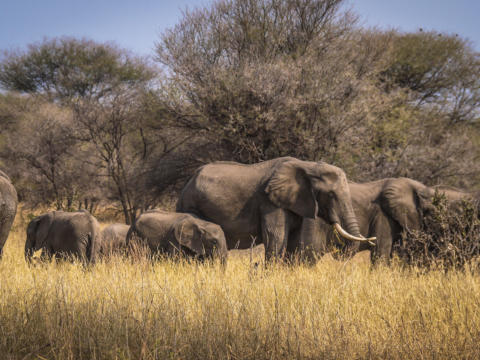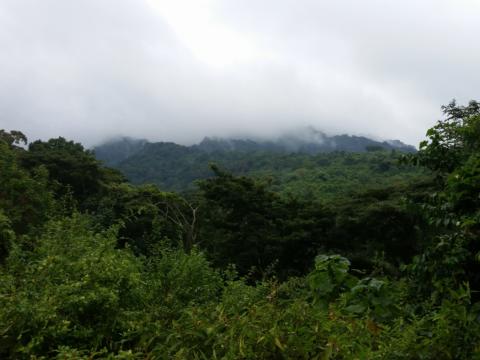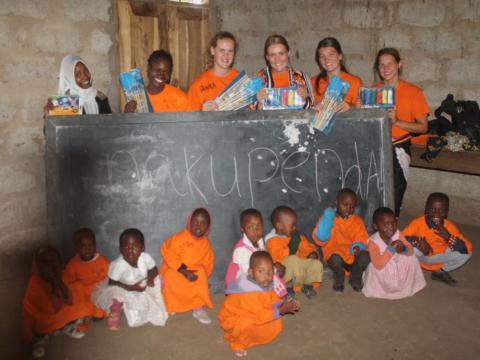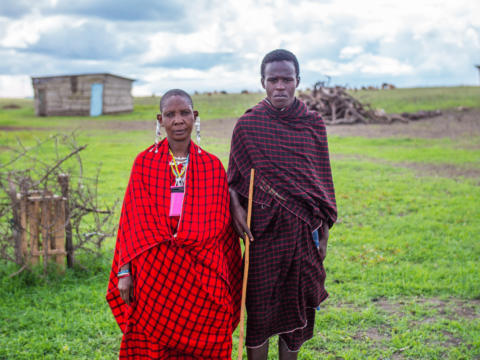Only 360€ per week!
Empowering Village Women
Arusha - Tanzania
Maasai Tribe communities are traditionally patriarchal, but now these amazing women are making their own way, which allows them to have their own say!
This program provides insight into the unique culture of the Maasai Tribe and the impact that is felt when the education of girls is not prioritized. The primary focus is on the development of basic skills and financial literacy of the local women, who are learning how they can earn funds to support themselves and educate their children.
Program Description
Maasai society have their own lifestyle which differs from other societies in Tanzania. They have their dressing styles, decorations and way of living. They wear the rectangular fabric popularly known as Shuka in Swahili language and which come in different colors. The majority of Maasai women throughout the many Maasai communities live a life of poverty and cultural oppression. Men are the heads of the households and the village. They have control of almost every aspect of life and hold almost all the leadership roles.
Moreover, Maasai women’s main source of income is through selling traditional beaded jewelry. However, due to their vulnerability in lack of education, women do not have a systematic way of financially protecting their own economic interests. In this regard, here is where you can support the Maasai women through a mutually beneficial exchange of information in making informed financial decisions.
In its essence, most of the women from Maasai tribes devote their time to milking, taking care of calves, and domestic work. This kind of labor is currently the priority allowed for women as there is less emphasis on education and community engagement which might allow women to have more options for sustainable development in the future.
The majority of the women in the village do not speak English, as such, you will be supervised on the ground by a locally trained coordinator to ensure there is a smooth communication between the women and yourself. The main goal is to facilitate Maasai women with a view to prepare their future that will guide them to have fruitful life into their old age.
Due to the remote location of this program and limited local transportation, you may be required to stay the first night in Monduli. Additionally, placement is in a Maasai village in Arusha, but to increase immersion you may get spread across various villages.
Aims & Objectives
- To help Maasai women to have income generating activities in order to cover costs for common service for their kids like pens, exercise books food and security.
- To assist the women to contribute to community development through their active participation.
- Strengthening the group and initiating subgroup projects to find and provide solutions to the challenges faced by the women.
- To mobilize and encourage women to enroll their kids (boys and girls) to schools and prevent early marriage.
- To facilitate workshops on Saving, loans and financial literacy for the group.
Schedule
Monday to Friday
- Breakfast
- Meet the Women of the group and provide insight into healthy measures to cater for their children and themselves
- Discuss sustainable projects with the Maasai women to be financially independent
- Lunch
- Discuss the importance of education with the Maasai women
- Engage with the women in different ways of mobilising their own resources (Table Banking and Saving Strategies)
- Dinner
Note: This schedule can be changed and/or amended depending on weather conditions, local conditions and unforeseen circumstances.
Note: Please keep in mind that in the village things are done on an as-needed basis. This is just an example of what your week might look like during your homestay, but activities may change depending on weather, community needs, ceremonies or other circumstances. Your flexibility and ability to adapt to changes in your new surroundings well will be of great benefit during this amazing experience.
Participant Criteria & Requirements
Standard Requirements
Minimum age: –
Maximum age: –
Minimum English level: Basic
CRB required: On Signup
Passport copy required: No
Resume copy required: No
Required qualification: None
Additional Requirements
There are no further requirements for this program.
Additional Equipment
- Modest clothing i.e. covering the knees and shoulders
- There is little or no electricity so flashlight, batteries, solar charger and a sleeping bag may be needed
- Sturdy shoes for the long walks you will take part in
- The village sometimes gets cold in the evening, so make sure to pack some warm clothes
- Mosquito and insect repellent is a highly recommended
- Alcohol based hand sanitisers, as there is limited access to water within the village
Location
You will be staying in a very simple, traditional, family home in a Maasai Village in Arusha. Located many kilometers away from the paved main road which leads into the nearest large city Arusha, with many smaller towns along the way. This village is quite a bit off the beaten path. The terrain is rough and scantily covered by grass, bushes, and trees. In the dry season inhabitants of the village must walk several kilometers to fetch water for cooking, drinking and occasionally for bathing.
About the Accommodation
Expect a very ‘back to nature’ approach during your stay here! You will live as a visitor in a homestay residence which may include the traditional house made from wood, sticks, cow dung and clay-soil. The Maasai generally live without electricity, and though some houses have recently acquired solar cells, you should not expect it. There is no running tap water and no western toilets. You can expect squatting toilets will be available and the occasional showering is done by using a bucket. All participants are expected to be environmentally aware and to use all resources with extreme restraint, especially water, paper, and electricity. This accommodation is in a Maasai village in Arusha, but to increase immersion you may get spread across various villages.
Food Arrangements
Meals are inspired by the local cuisine and consist of a lot of corn, rice, potatoes, and bananas. Beef, goat meat, beans, and a few green leafy vegetables will help to add nutrients to your daily meals as well. There are no shops within walking distance, so if you are a picky eater or feel that you may not be amenable to the local style meals, please feel free to bring supplemental food items with you from Monduli or Arusha, with the understanding that there is no refrigeration available.
Facilities
For stays in the Maasai villages, there are no ATM facilities, banks, post offices, or the local shops nearby. These can be around 60-150 minutes away depending on the mode of transportation (driving in a car, riding on a motorbike, or walking) being used.
Activities & Events
No scheduled activities outside the program.
Sights & Surroundings
National Parks
There are many national parks not far from this location where you can explore the wildlife and environment or take a safari trip on the weekend. Lake Manyara, Mount Meru, Kilimanjaro, Serengeti, and Ngorongoro can be found nearby and are the wonders of the region. Speak to a coordinator about where you can access the internet to help you get this arranged!
Ngorongoro Conservation Area
Expanding over plains, forests, and savannas, Ngorongoro Conservation Area hosts Ngorongoro Crater, the world’s largest caldera where incredible wildlife coexists with the Maasai. In here, you will be able to find wildlife… in a crater! A must when in Tanzania as it is one of the most emblematic locations of the continent.
Tarangire National Park
Tarangire is famous for its population of elephants and the symbolic Baobab tree. During the dry season, wild animals inhabit the park and you will be able to find zebras, giraffes, buffaloes, elephants, wildebeests and more! While not as common, you might be able to find a lion here as well if you are lucky!
Serengeti National Park
Serengeti is probably the most worldwide known National Park in the world. It is believed to hold the largest population of lions in the world! Aside from that, cheetahs, buffaloes, zebras, giraffes, rhinos, hippos live here. Make sure you allow yourself at least two days to visit and stay overnight in either a campsite or a lodge. Serengeti cannot be done in just one day as it is so huge!
Arusha National Park and Mount Meru
The home of Mount Meru, the second largest peak in Tanzania after Kilimanjaro. While it is not the best place to spot wildlife compared to Ngorongoro or Serengeti, it is still the home of many species including giraffes, warthogs, Cape buffaloes, lions, elephants, flamingos and more! However, the main attractions here are the landscapes that line the park to every side: to the west, you will find Meru Crater and the Jekukumia River. To the south, you will find Ngurdoto Crater and to the north.east, Momelia Lakes, which vary in color due to algae and are made even brighter by many different species of birds who love to swim in the water!
Lake Manyara National Park
During the wet season, pink flamingos brighten up the lake, which make it the go-to place for bird watchers. They do leave during the wet season, but Masai Lions, Leopards, hippos, giraffes, zebras, elephants, blue monkeys, gazelles and cheetahs can be found here year-round!
Moshi and Mount Kilimanjaro
Moshi is located about two and a half hours away from Monduli and can be easily reached from Monduli by taking a “dala dala” to Arusha and then another one to Moshi from there.
Moshi is a sleepy town with a Western vibe as it is the starting point of the Mount Kilimanjaro climb! On a clear day, you can get excellent views of the highest mountain in Africa (tip: head over to Moshi Train Station for a top-notch view. This station is no longer in use for transportation purposes, but the locals have made the most out of it by placing some chairs and selling drinks and snacks with a view!).
Kikuletwa Hot Springs
A lesser-known but still amazing attraction located between Arusha and Moshi are Kikuletwa Hot Springs. The water isn’t actually hot, but its temperature is perfect for swimming and relaxing. It is known as an oasis as it is covered with jungle and the water here is so blue that you wouldn’t believe! It is a favorite go-to place for locals and expats alike and there is even a rope you can use to dive into the water with style.
Arusha
Arusha is one of the main cities of Tanzania and is easy to reach from Monduli in less than an hour and a half. From here, most safari companies depart to many of the national parks surrounding it, so it is your go-to place for wildlife! In Arusha you will be able to find a myriad of things to do – from Maasai markets selling crafts to bring back home, to cinemas, shopping malls, Western food, and more!
Hiking Around Monduli
Monduli is set amidst lush mountains that are a great opportunity for hiking off-the-beaten path. There are numerous trails, one of which leads to a gorgeous waterfall. Speak to our coordinator to arrange, as the government needs to grant you permission (for a fee) to visit beyond certain spots in order to conserve the area.
Iringa and Ruaha National Park
Not that close by, but an interesting place nonetheless if you have the time after finishing our programs! Ruaha National Park is a much lesser visited place for wildlife, but its few visitors are never disappointed by its beauty! In fact, it is the largest National Park in Tanzania and boasts cheetahs, the second largest population of Leopards in Africa, buffalos, hippos, and more!
Zanzibar
While a bit far, it is possible to fly to Zanzibar for a weekend from Arusha airstrip, a small airport that operates domestic flights and is not too far from our center! Zanzibar is known for its sandy white beaches and unique culture. While here, don’t miss Stone Town, a place that is emblematic for its mazes and spices (take a spice tour for sure!). Another must is a visit to Prison Island, where you can spot dolphins and marine life. Travel north or east of the island for some of the best and cleanest beaches in the world and enjoy the Indian Ocean at its best!
Transportation
From this location we provide free transport to your next program at the following location(s):
- Monduli
Quick Facts
Name: United Republic of Tanzania
Population: 52 million
Capital: Dodoma
Language: Swahili, English
Currency: Tanzanian Shilling (TZS)
Time zone: EAT (UTC +3)
Country Information
Tanzania is a large country in Eastern Africa within the African Great Lakes region. Parts of the country are in Southern Africa and it is bordered by Kenya and Uganda to the north; Rwanda, Burundi, and the Democratic Republic of the Congo to the west; Zambia, Malawi, and Mozambique to the south; and by the Indian Ocean to the east. It is home to Kilimanjaro, Africa's highest mountain, in its northeastern region and is considered the Safari capital of the world!
Tanzania is a presidential constitutional republic, and since 1996, its official capital city has been Dodoma, where the President's Office, the National Assembly, and some government ministries are located. Dar es Salaam, the former capital and its largest city, retains most government offices and is the country's principal port and leading commercial centre.
Climate
Climate varies greatly within Tanzania. In the highlands, temperatures range between 10 and 20°C during cold and hot seasons respectively.
The rest of the country however has temperatures rarely falling lower than 20°C. The hottest period extends between November and February (25–31°C) while its coolest period occurs between May and August (15–20°C).
Tanzania has two major rainfall regimes: one is uni-modal (October–April) and the other is bi-modal (October–December and March–May). The former is experienced in southern, central, and western parts of the country, and the latter is found in the north from Lake Victoria extending east to the coast.
Culture
Tanzania's large population is diverse, composed of several ethnic, linguistic and religious groups.
Christians and Muslims make up the large majorities, but 2% still practice Traditional African Religion.
Over 100 different languages are spoken in Tanzania, making it the most linguistically diverse country in East Africa. All four of Africa’s language families are spoken (Bantu, Cushitic, Nilotic, and Khoisan), but Swahili and English are its official languages, though Swahili is pushed officially as a unifying language, to the detriment of other minority languages, even English.
Transportation
Car
Although much of its roads are usually in poor condition, most transport in Tanzania is by road, 80% of its passenger traffic in fact. Rentals, Taxis, buses and mini buses (locally known as “dala dala”) account for the main methods of transportation.
Train
Tanzania’s railways have a spotty safety record and it is not uncommon to have passengers experience frustration with slow journeys, frequent cancellations and delays, but if you have the time – it is a unique way to travel with amazing landscapes decorating the backdrop!
Airplane
Tanzania has four international airports, along with over 100 small airports or landing strips; airport infrastructure tends to be in poor condition although there are reports of improvements in this area. Local airlines in Tanzania include Air Tanzania, Precision Air, Fastjet, Coastal Aviation, and ZanAir.





